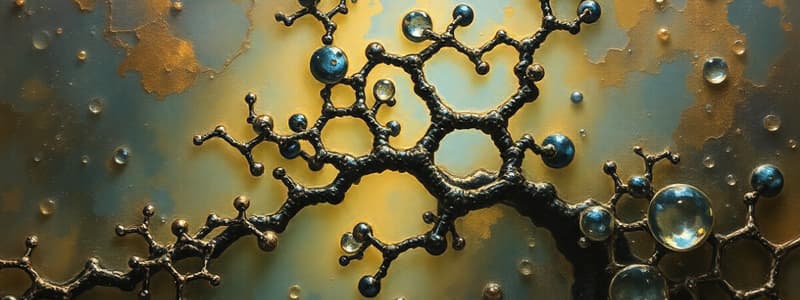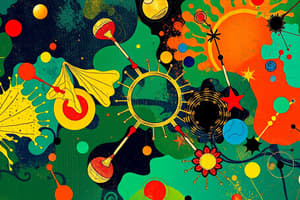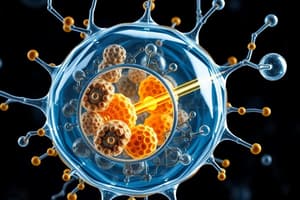Podcast
Questions and Answers
Which statement best describes matter?
Which statement best describes matter?
- Matter is purely a gas and cannot exist in other forms.
- Matter has no mass but occupies space.
- Matter can only exist in a solid state.
- Matter is anything that has mass and occupies space. (correct)
What determines the element's identity in an atom?
What determines the element's identity in an atom?
- The arrangement of electrons around the nucleus.
- The number of protons in the nucleus. (correct)
- The total mass of the atom.
- The number of neutrons present.
What type of particle is an electron?
What type of particle is an electron?
- Neutral particle contributing to mass.
- Negatively charged particle orbiting the nucleus. (correct)
- Positively charged particle in the nucleus.
- Part of the nucleus that defines the atomic number.
Which statement accurately describes neutrons?
Which statement accurately describes neutrons?
What is an ion?
What is an ion?
Which of the following correctly defines atomic number?
Which of the following correctly defines atomic number?
Which of the following best describes the function of sodium ions (Na⁺)?
Which of the following best describes the function of sodium ions (Na⁺)?
What role do enzymes play in biochemical reactions?
What role do enzymes play in biochemical reactions?
Which protein is primarily responsible for muscle contraction?
Which protein is primarily responsible for muscle contraction?
What distinguishes DNA from RNA?
What distinguishes DNA from RNA?
Which of the following is NOT a function of proteins?
Which of the following is NOT a function of proteins?
What is the structure of DNA?
What is the structure of DNA?
Which transport protein carries oxygen in the blood?
Which transport protein carries oxygen in the blood?
What is the main function of structural proteins?
What is the main function of structural proteins?
What is a primary function of hormones in the body?
What is a primary function of hormones in the body?
Which type of bond is formed by the sharing of electrons between atoms?
Which type of bond is formed by the sharing of electrons between atoms?
Which of the following is a primary function of hemoglobin?
Which of the following is a primary function of hemoglobin?
What is a consequence of high blood glucose levels in relation to wound healing?
What is a consequence of high blood glucose levels in relation to wound healing?
What type of fatty acids are typically found in oils, contributing to their liquid state at room temperature?
What type of fatty acids are typically found in oils, contributing to their liquid state at room temperature?
Which nutritional component is essential for tissue repair in wound healing?
Which nutritional component is essential for tissue repair in wound healing?
How can advanced wound care benefit patients with diabetic foot ulcers?
How can advanced wound care benefit patients with diabetic foot ulcers?
What impact does glycation of proteins have on the body?
What impact does glycation of proteins have on the body?
What is a common characteristic of diabetic foot ulcers?
What is a common characteristic of diabetic foot ulcers?
What is the primary function of carbohydrates in the body?
What is the primary function of carbohydrates in the body?
Which of the following is a characteristic of monosaccharides?
Which of the following is a characteristic of monosaccharides?
Which of the following statements about triglycerides is true?
Which of the following statements about triglycerides is true?
What distinguishes saturated fatty acids from unsaturated fatty acids?
What distinguishes saturated fatty acids from unsaturated fatty acids?
What is the role of cholesterol in the body?
What is the role of cholesterol in the body?
Which type of carbohydrate is formed by the combination of two monosaccharides?
Which type of carbohydrate is formed by the combination of two monosaccharides?
What is the simplest form of protein building blocks called?
What is the simplest form of protein building blocks called?
Which of the following types of lipids is primarily involved in forming cell membranes?
Which of the following types of lipids is primarily involved in forming cell membranes?
What does the mass number of an atom represent?
What does the mass number of an atom represent?
Which of the following correctly defines a mole?
Which of the following correctly defines a mole?
In which phase change does a solid become a liquid?
In which phase change does a solid become a liquid?
Which statement about ionic bonds is correct?
Which statement about ionic bonds is correct?
Which type of bond occurs when two atoms share electrons equally?
Which type of bond occurs when two atoms share electrons equally?
What is the reason for water's polarity?
What is the reason for water's polarity?
What happens during the process of condensation?
What happens during the process of condensation?
Which of the following best describes hydrogen bonds?
Which of the following best describes hydrogen bonds?
How does water affect body temperature regulation?
How does water affect body temperature regulation?
Which of the following describes polar covalent bonds?
Which of the following describes polar covalent bonds?
What is the significance of sodium chloride (NaCl) in the human body?
What is the significance of sodium chloride (NaCl) in the human body?
What is a function of water's cohesion?
What is a function of water's cohesion?
What does a pH value of 8 indicate about a solution?
What does a pH value of 8 indicate about a solution?
Which of the following is a characteristic of organic molecules?
Which of the following is a characteristic of organic molecules?
How does water act as a solvent?
How does water act as a solvent?
What is a key property of hydrogen bonds in water?
What is a key property of hydrogen bonds in water?
Flashcards
What is matter?
What is matter?
Anything that has mass and takes up space. In the human body, it includes substances like bones, muscles, and fluids.
What is an atom?
What is an atom?
The fundamental building block of matter, composed of a nucleus with protons and neutrons, surrounded by orbiting electrons.
What is a proton?
What is a proton?
Positively charged particles found in the nucleus of an atom. The number of protons determines the element's identity.
What is an electron?
What is an electron?
Signup and view all the flashcards
What is a neutron?
What is a neutron?
Signup and view all the flashcards
What is an ion?
What is an ion?
Signup and view all the flashcards
What is a cation?
What is a cation?
Signup and view all the flashcards
What is an anion?
What is an anion?
Signup and view all the flashcards
Intermolecular bonds
Intermolecular bonds
Signup and view all the flashcards
Hydrogen bonds
Hydrogen bonds
Signup and view all the flashcards
Solvent
Solvent
Signup and view all the flashcards
Specific Heat
Specific Heat
Signup and view all the flashcards
Cohesion
Cohesion
Signup and view all the flashcards
Adhesion
Adhesion
Signup and view all the flashcards
pH
pH
Signup and view all the flashcards
pH scale
pH scale
Signup and view all the flashcards
What is the mass number?
What is the mass number?
Signup and view all the flashcards
What is a mole?
What is a mole?
Signup and view all the flashcards
What is melting?
What is melting?
Signup and view all the flashcards
What is evaporation?
What is evaporation?
Signup and view all the flashcards
What is condensation?
What is condensation?
Signup and view all the flashcards
What is a chemical bond?
What is a chemical bond?
Signup and view all the flashcards
What is an ionic bond?
What is an ionic bond?
Signup and view all the flashcards
What is a covalent bond?
What is a covalent bond?
Signup and view all the flashcards
What are enzymes?
What are enzymes?
Signup and view all the flashcards
What is Amylase?
What is Amylase?
Signup and view all the flashcards
What are Structural Proteins?
What are Structural Proteins?
Signup and view all the flashcards
What is Collagen?
What is Collagen?
Signup and view all the flashcards
What are Contractile Proteins?
What are Contractile Proteins?
Signup and view all the flashcards
What are Transport Proteins?
What are Transport Proteins?
Signup and view all the flashcards
What is Hemoglobin?
What is Hemoglobin?
Signup and view all the flashcards
What are Hormones?
What are Hormones?
Signup and view all the flashcards
What are monosaccharides?
What are monosaccharides?
Signup and view all the flashcards
What are disaccharides?
What are disaccharides?
Signup and view all the flashcards
What are polysaccharides?
What are polysaccharides?
Signup and view all the flashcards
What are lipids?
What are lipids?
Signup and view all the flashcards
What are triglycerides?
What are triglycerides?
Signup and view all the flashcards
What are phospholipids?
What are phospholipids?
Signup and view all the flashcards
What are fatty acids?
What are fatty acids?
Signup and view all the flashcards
What are proteins?
What are proteins?
Signup and view all the flashcards
Covalent bond
Covalent bond
Signup and view all the flashcards
Hemoglobin
Hemoglobin
Signup and view all the flashcards
Nucleotide
Nucleotide
Signup and view all the flashcards
Cohesion of water
Cohesion of water
Signup and view all the flashcards
Adhesion of water
Adhesion of water
Signup and view all the flashcards
Diffusion
Diffusion
Signup and view all the flashcards
Osmosis
Osmosis
Signup and view all the flashcards
Glycation of proteins
Glycation of proteins
Signup and view all the flashcards
Study Notes
Basic Concepts
- Matter is anything with mass that occupies space, existing as solids, liquids, or gases.
- Atoms are the fundamental unit of matter, consisting of a nucleus (protons and neutrons) surrounded by orbiting electrons.
- Protons are positively charged particles in the nucleus, defining the element's identity (atomic number).
- Electrons are negatively charged particles orbiting the nucleus, influencing atomic interactions.
- Neutrons are neutral particles in the nucleus, contributing to atomic mass.
- Ions are atoms or molecules with a net electrical charge due to gained or lost electrons.
- Cations are positively charged ions (lost electrons).
- Anions are negatively charged ions (gained electrons).
Atomic Structure
- Atomic number is the number of protons, placing each element on a periodic table.
- Mass number is the sum of protons and neutrons in an atom's nucleus, approximating its mass.
- Moles measure the amount of a substance, containing Avogadro's number (6.022 × 1023) of particles.
Phase Changes
- Melting: solid to liquid
- Evaporation: liquid to gas
- Boiling: rapid transition from liquid to gas at the boiling point
- Condensation: gas to liquid
- Freezing: liquid to solid
Chemical Bonds
- Chemical bonds hold atoms together, forming molecules.
- Ionic bonds are formed when one atom donates an electron to another, creating opposite charges attracting them.
- Covalent bonds occur when atoms share electrons.
- Nonpolar covalent bonds share equally; polar covalent bonds share unequally.
- Intermolecular bonds are weaker forces between molecules, affecting properties.
Inorganic Chemistry
- Water (H2O) is the most abundant molecule in the human body.
- Water's properties (polarity, high specific heat, cohesion/adhesion) are crucial for life.
- Water is a solvent, dissolving many substances.
Organic Chemistry
- Organic molecules contain carbon.
- Carbohydrates are the body's primary energy source, including monosaccharides (simple sugars), disaccharides (two sugars), and polysaccharides (many sugars).
- Lipids are hydrophobic organic molecules (fats, oils, cholesterol) storing energy and forming cell membranes.
- Proteins are complex molecules composed of amino acids, with various functions like enzymes, structural components, and hormones.
- Nucleic acids (DNA and RNA) store and transmit genetic information.
pH
- pH measures the concentration of hydrogen ions (H+) in a solution, indicating acidity or alkalinity.
- A pH of 7 is neutral; less than 7 is acidic; greater than 7 is alkaline.
Studying That Suits You
Use AI to generate personalized quizzes and flashcards to suit your learning preferences.




